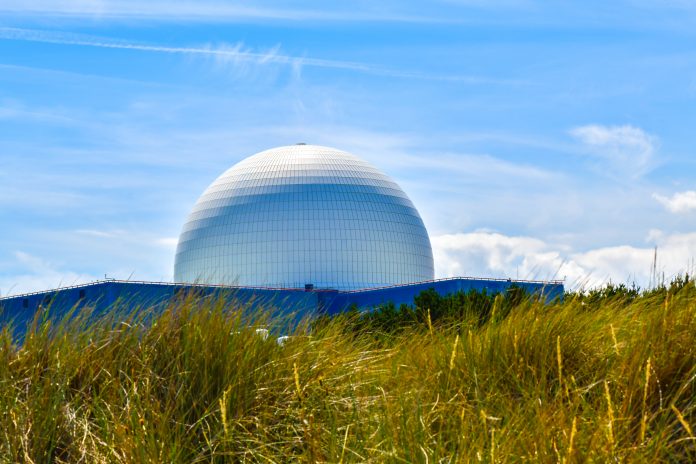Nuclear power is an integral part of the UK’s plans to transition to net zero carbon emissions by 2050
Nuclear power currently supplies about 16% of the UK’s electricity, but its existing fleet of reactors are approaching the end of their operating lives. With the exception of Sizewell B and Hinkley Point C, which is under construction, all of the UK’s existing nuclear power plants are to be closed by the end of 2030.
The government has already committed to ending the use of coal by 2025 and retiring capacity will need to be replaced to keep pace with existing levels of demand, which the government predicts could double by 2050.
A consortium led by Rolls-Royce has announced plans to build up to 16 mini-nuclear plants, referred to as “small modular reactors” (SMR). Rolls-Royce and its partners argue that instead of building nuclear mega-projects, the UK should construct a series of smaller nuclear plants from “modules” made in factories.
The goal is to redesign nuclear power plants into a very high-tech prefabricated kit, in which components are broken down into a series of modules that would be made in a factory and then shipped by road to the site for assembly.
The consortium argues their approach will overcome the biggest problem nuclear power faces, which is the exorbitant cost. The reason it is so expensive to build large nuclear plants is that the projects are huge and complex and must meet very high safety standards. Each SMR plant would produce 440 megawatts of electricity, enough to power a city, at a cost of around £2 billion each. To provide context, the Hinkley Point C will produce 3,200 megawatts at a cost exceeding £20 billion.
One of the other benefits put forth by the Rolls Royce consortium is, their new approach is to make them smaller and make lots of them so that we get really good at it. They argue that because so few new nuclear power stations are actually built, there are very few opportunities to learn from mistakes. Mistakes, which have devastating and long lasting effects.
It was in the early hours of Saturday 26th April 1996 just outside the city of Pripyat in Northern Ukraine when a reactor exploded at the Chernobyl Nuclear power plant. Though the Chernobyl nuclear disaster is considered one of the world’s worst, the explosion claimed only 2 lives, with an additional 29 firefighter deaths being recorded in the following days and months from radiation exposure.
The Chernobyl disaster, along with the Fukushima disaster in Japan are the only two nuclear accidents to receive a level 7 (the maximum classification) on the International Nuclear Event Scale. Though relatively few deaths were recorded at Chernobyl and no deaths were recorded as a direct result of the Fukushima disaster, the ecological and environmental damage has been immeasurable, laying waste to vast areas and making them uninhabitable for decades.
The number of people who were impacted by long-term radiation exposure is more difficult to estimate, mainly due to the difficulty that lies in the methodology used to estimate long-term deaths from low-level radiation exposure. The ‘linear no-threshold model’ (LNT) is highly contested and calculates the long term effects of radiation exposure. In the ten years after the Chernobyl disaster, the LNT model attributed an additional 14 suspected radiation-induced cancer deaths.
In the aftermath of the Fukushima disaster the German government quickly passed legislation to decommission all of their nuclear reactors, as a means to keep its citizens safe by preventing a Fukushima-style disaster and the German engineering giant Siemens announced its withdrawal from the nuclear industry, and confirming it would no longer build nuclear power plants anywhere in the world.
Many other nations also either delayed or dialled back their plans for nuclear plants after Fukushima and many experts predicted that accidents like Chernobyl and Fukushima could see the eventual demise of nuclear altogether. However, over time confidence has slowly returned along with investment and funding and the future looks promising, even with a technology which, in principle, is decades old.
Nuclear Fission versus Nuclear Fusion
Fission is the nuclear process that is currently run in nuclear power plants. It is triggered by uranium absorbing a neutron, which renders the nucleus unstable. The result of the instability is the nucleus breaking up and producing more neutrons, which in turn hit more uranium atoms and make them unstable and so on. This chain reaction is the key to fission reactions, but it can lead to a runaway process resulting in nuclear accidents.
Unlike nuclear fission, fusion is still in the research and development phase, but the nuclear fusion reaction in a tokamak is an inherently safe reaction, but incredibly complex process. Early in December 2020 the UK government invited communities around the country to volunteer a site for a prototype fusion reactor, which could be the first to provide electricity into the grid. The project, called Spherical Tokamak for Energy Production (STEP), began last year with an initial £222 million over 5 years to develop a design, with a goal of construction starting as soon as 2032 and operations by 2040.
The race is on around the world to build the first fusion reactor because fuel sources are relatively plentiful and radiation concerns are slight compared with nuclear fission reactors. Once the technology is deemed viable it will start a new era of nuclear energy, which will be safer, cheaper and more plentiful than our current nuclear options that are plagued with disasters, fear of disasters and exorbitant costs.












Why is Thorium/Flouride not on the agenda?
Its cheaper, more available fuel, non-weaponisable, can use up legacy spent fuels, has less waste, can be delivered from small sites using existing power heads to grid, is good for local regeneration and brownfield site re-use.
Denmark,Germany, US, China and India are already doing it. It’s not possible to get meltdowns and so UK gov is going for grandiose wasteful polluting old tech instead.
Don’t we have the leadership that accepts better technology?
Does the UK not have the courage to innovate seriously?
Are we fixated on Uranium?
Are the contracts not big enough?
Is the electricity now expensive enough?
Does it just upset too many vested interests?
Don’t our politicians concern themselves with new things?
Even Bill Gates in investing in smaller Uranium/Sodium plants which don’t have the meltdown risks.